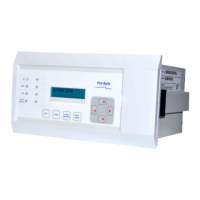I
eq
= √ (Irms² + (K Coefficient* I
2
²) ----------- (1)
Where
I
rms: RMS current corresponding to the largest phase current.
I
2
: Negative phase sequence current.
K Coefficient is a constant proportional to the thermal capacity of the motor.
The equivalent motor heating current assuming K = 3 for (1) become:
I
eq
= √ [4/3 * ( Iinject )
2
]
= (2 I
inject / √3) ----------- (2)
The equation used to calculate the trip time at 100% of thermal state is:
t = τ ln ((K²- A²)/ (K²- 1))
Where:
t: Time to trip (in seconds)
τ: Thermal time constant depending on the current value absorbed by the motor:
• Overload time constant τ= T
1 if IFL < Ieq ≤ 2xIFL
• Start-up time constant τ= T
2 if Ieq> 2xIFL
• Cooling time constant τ= T
r if interrupting device opened
K: Thermal overload equal to (Irms / k* IFL)
Where:
I
rms: RMS current corresponding to the largest phase current
IFL: Thermal trip or full load current rating (settable)
k : Settable (1 to 1.5 step 0.01)
A: Initial thermal state (eg. If the initial thermal state is 50% then A =0.5)
The time to a thermal trip becomes:
t = τln(k
2
/(k
2
–1))
The equation used to calculate the time to the thermal alarm is:
t
alarm = τln(k
2
/(k
2
–Thermal Alarm /100))
Thermal Alarm =Alarm Threshold setting in percentage
Since a current of twice the setting IFL is applied, consequently one of the following thermal constants
is used:
• T
1 (overload time constant) if the interrupting device is closed.
• T
r (cooling time constant) if the interrupting device is opened.
Apply a current of twice the setting [in cell: CONFIGURATION, IFL] to the relay and make a note of
the time displayed when the timer stops. Check that the operating time recorded by the timer is within
the range (as specified in the Chapter: Technical Specification). For all characteristics, allowance
must be made for the test equipment being used.
Example
For IFL= 0.5 A and A phase I
inject= 2 A, T1 = 5 mins

